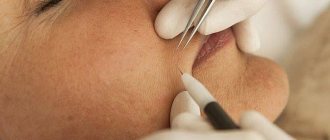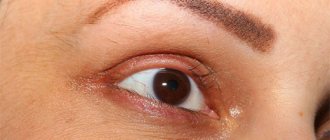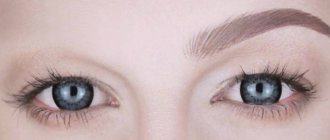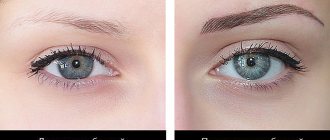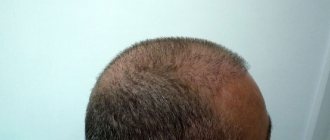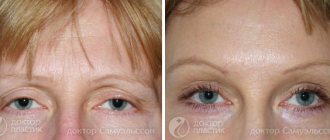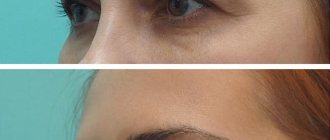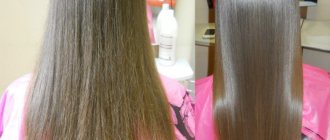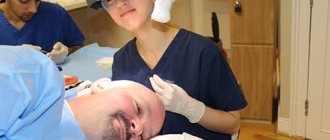FUE hair transplantation is a machine transplantation of follicles obtained from the occipital region or other parts of the body to create thick and symmetrical eyebrow shape.
Indications
Hair transplantation into the eyebrow area using the FUE method is indicated in the following cases:
- the need to disguise post-acne, burns, scars and cicatrices, traces of plastic surgery, tattooing and microblading;
- desire to change the shape of the eyebrows taking into account the geometry of the face;
- thinning and loss of eyebrows as a result of aggressive plucking;
- violation of eyebrow symmetry;
- hormonally or genetically determined rare vegetation;
- loss due to internal diseases, severe stress.
results
During the day after hair transplantation, you should be careful and protect the recipient area from any influences.
The wound points from the microchannels on the scalp into which the grafts were transplanted remain barely noticeable for a week. Compliance with the hair transplant technique eliminates the development of infectious and cicatricial complications in the recipient and donor areas. The seam on the back of the head during hair transplantation using the strip method disappears under the hair after a month and becomes indistinguishable.
The survival rate of grafts after hair transplantation is 98% for androgenetic alopecia and 95% for cicatricial alopecia. The growth of transplanted hair begins after 3-4 months and continues throughout the rest of life. Hair after transplantation retains its naturalness: in the future it can be cut, dyed, styled, etc.
The appearance of the future hairstyle depends not only on the number of transplanted grafts, but also on the structure of the hair itself - its color, diameter, waviness, etc.
Advantages
FUE hair transplant is the most effective transplant method. It has a number of undeniable advantages:
- low morbidity;
- no risk of complications;
- no scars or bruises remain;
- efficiency - as a result of one procedure, you can achieve a density of 80 hairs / 1 sq. cm;
- high survival rate;
- The transplanted hair remains for life.
Transplant procedure
During the face-to-face consultation, issues of the feasibility and scope of transplantation are discussed, the level and shape of the hairline is selected, and the stages of work are demonstrated. Based on the condition of the scalp, the area of baldness, the presence of residual hair and its quantity in the donor area, the volume of transplantation and the price of hair transplantation are determined.
The hair transplant procedure is performed on an outpatient basis; Depending on the chosen method and volume, it can last from 3 to 6 hours. When performing a hair transplant, local anesthesia is used.
Hair transplantation involves moving grafts from areas of the scalp that are protected from hair loss to areas that are partially or completely hairless. The area of the back of the head or temples is used as a donor area.
At the first stage of transplantation, the required amount of material is taken from the donor area. To do this, the hair in the donor area is shaved and local anesthesia is applied to the scalp. Depending on the method of hair transplantation, a strip of skin is removed from the donor area (strip method) or individual grafts are removed with a special instrument with a tip (FUE method).
For further hair transplantation, only high-quality viable grafts are used, which are carefully selected under magnifying stereo microscopes. Typically, each graft contains from 1 to 4 hair follicles. Before transplantation, the grafts are stored in saline at a temperature of 4°C.
At the next stage of hair transplantation, after anesthetizing the recipient area, the required number of microchannels are formed in it with special needles, into which the formed grafts are placed.
The hair transplant procedure requires precise precision and utmost attention of the transplantologist and his assistants at all stages of the procedure. In addition, to achieve maximum graft survival, they must be handled with extreme care. When transplanting grafts, it is important to observe the direction of hair growth in order to maintain the natural appearance of the future hairstyle.
At the end of the hair transplant procedure, the filling of the channels is monitored under magnifying optics. The price of hair transplantation using the seamless method is higher than that of the patchwork method.
Preparation for hair transplantation
Before transplantation, the doctor determines the donor area for transplantation. Typically, hair is taken from the back of the head, chin and cheeks if there is stubble (in men), behind the ears, on the neck - where the hairs are thinner and shorter. This or that donor zone is selected according to the thickness of the hair. If a patient comes with the problem of partial hair loss on one eyebrow, then the second eyebrow can act as a donor. Before the procedure, the patient must follow a number of rules:
- 2 weeks before the appointed date, you must stop taking medications that stop baldness;
- drugs that affect blood clotting should be eliminated within a week;
- restrictions on smoking and drinking alcohol.
Reasons for the popularity of the procedure
“Eyebrows have been transplanted since the advent of transplantation. The procedure became the most popular in the 2000s - then it was relevant exclusively for patients who had suffered various types of injuries,” says Artur Albertovich Alexandrov, plastic surgeon at the international clinic of aesthetic innovations “Mediaesthetic”, trichologist-transplantologist, author of an exclusive method of treatment and restoration and strengthening hair. — As is known, there are no follicles on the scars left after injuries, so hair does not grow there. But today transplantation is also performed for aesthetic reasons. Interest in the operation especially increased when wide, thick eyebrows became fashionable.”
Instagram content
This content can also be viewed on the site it originates from.
Hair transplant process
The procedure is performed under local anesthesia and takes about 2 hours. At the first stage, using a “punch” (a rotating punch with a diameter of 0.5 to 5 mm), donor material is collected - skin along with a group of hair roots.
At the second stage of transplantation, the material removed and treated with a special solution is installed into the thickness of the skin of the eyebrow. To do this, the surgeon makes microscopic punctures or incisions into which the grafts will be placed using tweezers.
At the same time, the natural angle and direction of hair growth is respected. At the final stage, the eyebrows are treated with antiseptic and disinfectant preparations, the preliminary result is shown to the patient, after which the doctor makes a dressing.
When might eyebrow transplantation be needed?
Sometimes eyebrows are missing due to damage and injury, as well as alopecia. But in some cases, a person simply wants to correct the shape of their eyebrows and make them thicker. eyebrow hair transplant recommended :
- hair follicles have been lost due to chemical exposure;
- hormonal imbalance has caused the hair in this area to thin out;
- unsuccessfully performed permanent makeup;
- the natural hairline has been disrupted due to neurotic disorders;
- there are scars and scars in the eyebrow area;
- eyebrows are asymmetrical, have problematic width, density or shape.
With the help of transplantation, eyebrows can be made more attractive from an aesthetic point of view.
Contraindications:
- problems with blood clotting;
- allergy to local anesthesia;
- diabetes;
- pregnancy and breastfeeding;
- scleroderma, dermatomyositis.
After the procedure, hair grows naturally throughout your life.
Rehabilitation period
The donor area is restored within 3 - 5 days. The transplanted follicles take root within the first month. The first days after the procedure, it is necessary to avoid contact of the transplanted hair with any surfaces.
For 10 days, it is necessary to avoid activities that cause a sharp change in blood supply and increased sweating. Smoking and drinking alcohol are not recommended. It is also recommended to avoid prolonged exposure to open sun. Light sports are allowed 10 to 15 days after transplantation.
In addition, for the first 3 weeks you should exclude visiting the pool and sauna. After complete healing, the skin of the eyebrows remains smooth, maintaining a natural appearance.
Eyebrow transplant. How is eyebrow transplant performed? Eyebrow transplantation. Ivan Pavlovich Chesalin
What eyebrows look like after transplantation. Eyebrows the day after transplant. Eyebrow care.
What to consider before eyebrow transplant
Usually the donor area in this case is the occipital region. It is worth considering that the hair there is, by definition, long. After transplantation, they will also grow rapidly. Therefore, they need to be shortened regularly (every few days). To adjust the length of the hairs, you can use scissors from a manicure set or a special trimmer.
It is also worth remembering that eyebrow transplantation is, although minimally invasive, still an operation. Therefore, you should take all preparatory processes and the rehabilitation period seriously and strictly follow the doctor’s recommendations. If you still have questions about eyebrow transplants for girls in Moscow, request a call back. Sign up for an initial consultation, share your problems - together we will find the best way out of this situation.
Contraindications
- chaotic hair loss throughout the body, total alopecia;
- hair loss caused by radiation or chemotherapy;
- systemic diseases (eg, diabetes, hypertension, tumors);
- rapid progression of androgenetic alopecia;
- diseases of the blood and skin;
- the exact cause of hair loss has not been established;
- acute mental or psychological illnesses;
- lack of hair in the donor area.
| Hair transplantation to the eyebrow area - Dr. Ivan Palovich Chesalin Prices include a promotion with a 50% discount with permission to publish the results of photos and videos | |
| Initial comprehensive consultation | Without payment |
| Cost of hair transplantation in the eyebrow area of the first degree | 76,000 rubles instead of 152,000 rubles, subject to publication of the results |
| Cost of hair transplantation in the eyebrow area of the second degree | 83,000 rubles instead of 166,000 rubles, subject to publication of the results |
| Cost of hair transplantation in the eyebrow area of the third degree | 95,000 rubles instead of 190,000 rubles, subject to publication of the results |
| The price includes everything except tests. | |
Sign up for a consultation
Eyebrows and eyelashes: reconstruction and thickening
People most often lose eyelashes and eyebrows due to injuries and wounds, electrical, thermal and chemical burns, local diseases and somatic diseases; as a result of plucking to give the eyebrows a certain shape, permanent tattoo, or with neuroses, during or after radiation and chemotherapy, surgical operations to remove tumors. Sparse eyelashes and eyebrows or the absence of them - all this may be a sign of congenital characteristics of the body.
Restoration and thickening of eyebrows is carried out under local anesthesia. During the procedure, surgeons at the Volosy.ru clinic mainly use single and double grafts, or micrografts, achieving absolute naturalness in everything regarding the eyebrow contour chosen by the patient and the transplantologist, and the planned thickness. Doctors determine the location of the donor collection, taking into account the aesthetic component of the procedure, in order to transplant the finest hairs, thus achieving the highest possible visual authenticity with a natural “fit.” The grafts are transplanted into incisions specially made for them. If the initial sparseness was significant, surgeons may suggest additional surgery to thicken the eyebrows. The second procedure is carried out approximately a year after the first, when the hair has already grown.
In order to “help” the transplanted grafts follow the growth direction specified by the surgeon, patients are recommended to use special gels at first, as new hairs sprout, and, of course, trim their eyebrows with nail scissors as an auxiliary procedure.
When restoring eyelashes, surgeons at the Volosy.ru clinic collect the finest hairs using a patchwork FUT or seamless FUE method from the occipital region of the patient’s head, just as when reconstructing eyebrows. These are usually “twos” (grafts containing two hairs) that are transplanted into the coronal incisions of the eyelid margin.
The Volosy.ru clinic has accumulated exclusive experience in such operations. Back at the end of 2004, our surgeons began with the classical technique of planting micrografts in the coronal incisions of the eyelid margin. The results were monitored over three subsequent years. The very first patient who lost her eyelashes due to injury had her eyelash thickening done in 2005, followed by another correction in December 2006. The cosmetic result pleased both the patient and the doctors.
Since 2007, the Volosy.ru clinic has been practicing the method of “stitching” grafts into the tissue of the eyelids, which transplantologists, however, have slightly changed, using their own version of the needle as opposed to the “French needle” (Alan J. Bauman MD). Modeling nature, doctors try to produce grafts for transplantation not so much as “singles”, as in a number of other clinics, but rather grafts with double hairs, because eyelashes usually grow in groups of two or three hairs.
With careful processing of each graft, the fiber around the hair shaft and the follicle itself is removed as much as possible, thereby not overloading the eyelid tissue with additional subcutaneous tissue, which means that the architectonics of the subcutaneous layer of the eyelid is completely preserved. A newly created row of new eyelashes is transplanted over and between the sparse natural hairs. Approximately twelve months after transplantation, a second procedure is allowed to thicken the eyelashes.
The most common side effect is itching, which bothers patients for several postoperative days. But, alas, you should not scratch the transplant area, otherwise the new eyelashes may be damaged or become infected and may not even take root. In order not to fall into the trap of a sudden desire to disturb the operated eyelids, it is recommended to cover them with sunglasses for a while and use anti-itch medications. When the hairs begin to grow, a special oil and a device for curling eyelashes will help them grow in the direction specified by the surgeons.
Contraindications for eyelash transplantation are parasitic, fungal and microbial infections. Surgical intervention is also not recommended for cases of alopecia areata affecting the eyelids, with its unclear genesis and often unpredictable results.
